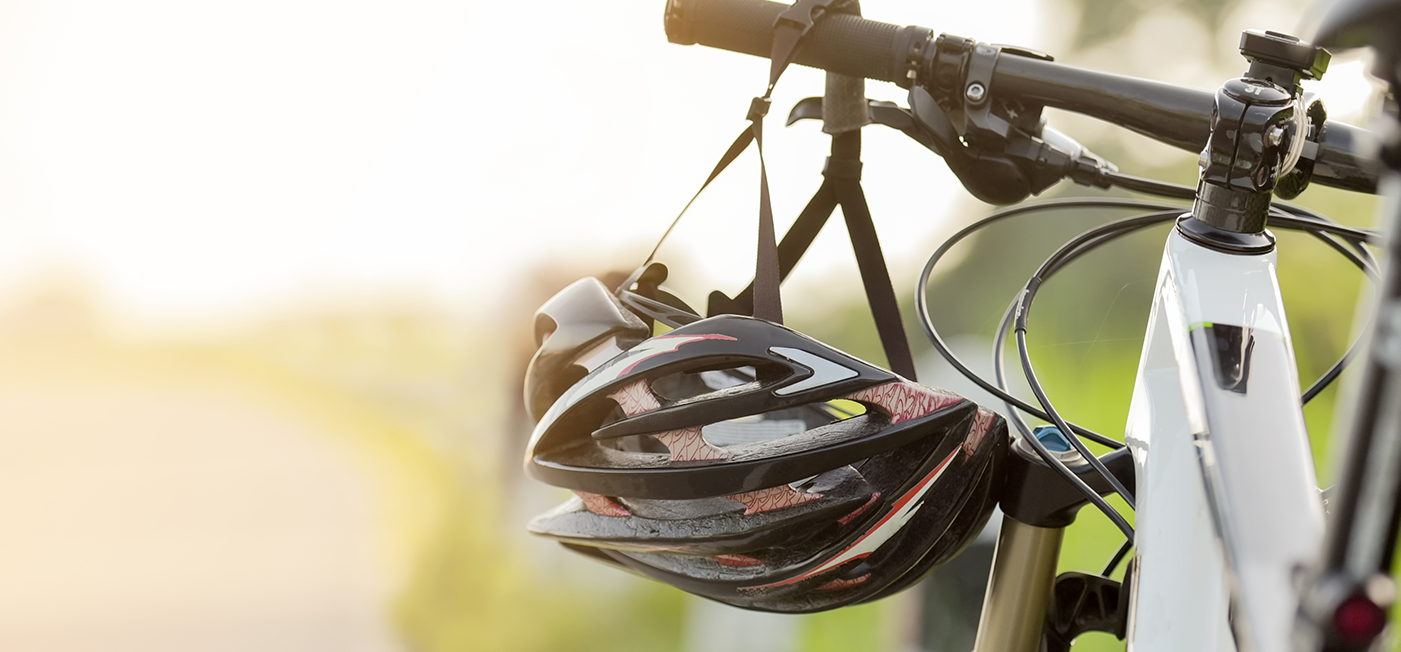Which bicycle or motorcycle helmet is suitable for hearing implant users?
For users of cochlear implants, other hearing implants or even hearing aids, it is often difficult to find a suitable helmet for two wheeled sports. In addition to legal aspects, a well-fitted helmet protects both the head and the implant; the market offers flexible solutions.

"After a heavy fall with my bike, thank God without damaging the implants, I bought a new helmet in a specialized store," says our CIA sports and fitness officer Gabriele Woditschka. When riding mopeds and motorcycles, the Highway Code prescribes the use of a crash helmet. When cycling, helmets are mandatory for children up to the age of twelve, regardless of whether they ride it themselves or sit in a child seat or bike trailer; for older children and adults, helmets are recommended as a minimum. This is especially true for users of a hearing implant, as the helmet also protects the skull area around the implant from impacts during falls.
"I bought a cheap helmet from an online store and used a Stanley knife to cut out the Styrofoam where I needed space for my audio processors," admits Max Sailer, an enthusiastic cyclist who is also responsible for retirees at CIA. In his search for a well-fitting helmet that would also fit his audio processors without such an adaptation, he has yet to find one: "In my opinion, it's better to wear a tampered helmet than no helmet at all."
When asked, the Austrian Road Safety Board KFV explicitly points out that independent manipulation of safety helmets is not recommended: "Please always contact the manufacturer, as independent manipulation can lead to severe safety restrictions of the helmet."
Many hearing system users also find that standard helmets fit securely yet comfortably, even with hearing systems. Manufacturers' offerings for customization range from bicycle helmets with Velcro pads to custom motorcycle helmets.
Bicycle helmet: Enough space for ponytail and cochlear implant
A bicycle helmet should be tried on before making a purchase in any case. The hard shell and foam should provide enough space for the hearing instruments and the headband should be positioned in a way that it does not lie across the implant and audio processor. A good distance between the chin strap and the hearing system is usually ensured by wide Y-bands. Victor Senn from IGGH mentions some helmets from UVEX as examples, and we also found some from ABUS and other manufacturers. Commercially available helmets are usually suitable for adolescents and adults with BTE devices; however, users of single-unit processors might have to search a little longer.
Victor Senn of the IGGH recommends bicycle helmets that can be individually fitted to the helmet wearer's head with additional Velcro straps: The hearing instruments can be left out in the process. The FIXTURE XL MIPS trail helmet and the enduro helmet from Giro, or certain products from UVEX are some examples. The IGGH has also received a recommendation for the ponytail-compatible models GameChanger, Skurb and Viantor from ABBUS, which probably offer relatively much free space around the ears, too. The declared recess for long hair or ponytail, however, is located at the back of the helmet, he adds. "Ponytail compatible" is therefore not a clear characteristic for "CI compatible", but an indication of ample free space.
Toddlers in bike trailers or child seats also need a helmet: The search for a suitable helmet can be particularly difficult for their parents. This is due to the fact that bicycle helmets for toddlers cover larger areas than is usual for adolescent and adult helmets, according to the U.S. Bicycle Helmet Safety Institute. The institute suggests the smallest "youth helmet" as a solution, as soon as it fits. For adults, the institute recommends helmets in "universal sizes" that can be adjusted to the head size in a wide range using adjustable straps.
Gabi Woditschka found what she was looking for at the manufacturer Lazer: Without any manipulations, the Magma+ helmet fits even her RONDO 2 processors. " It fits perfectly thanks to the internal lock. And the RONDOs are also protected from the rain!"
Motorcycle helmet: the cochlear implant as a type of communication device
Integral helmets for motorcyclists completely cover the ears and the surrounding area. For optimal safety, they must fit tightly to the head. Here there is less free space for hearing aids than in a bicycle helmet; pressure on the hearing aid can quickly become uncomfortable. However, more or less every motorcycle helmet manufacturer offers models with special recesses for communication devices and headphones: Victor Senn from IGGH also advises hearing system users to look for a suitable model among these.
Senn has found a special solution with the Japanese manufacturer SHOEI with its Personal Fitting System P.F.S.. This solution involves the custom fitting of a motorcycle helmet. The customer's head is measured by the expert staff, and special features - such as audio processors or hearing aids - are recorded as well. SHOEI estimates that the measurement will take about ten minutes, and the custom fitting of the helmet up to 30 minutes. The recommended price for this retail service is an additional 60 euros to the identical "off-the-shelf" helmet. Any additional head and cheek pads required will be charged extra.
Senn has found a special solution with the Japanese manufacturer SHOEI with its Personal Fitting System P.F.S.. This solution involves the custom fitting of a motorcycle helmet. The customer's head is measured by the expert staff, and special features - such as audio processors or hearing aids - are recorded as well. SHOEI estimates that the measurement will take about ten minutes, and the custom fitting of the helmet up to 30 minutes. The recommended price for this retail service is an additional 60 euros to the identical "off-the-shelf" helmet. Any additional head and cheek pads required will be charged extra.
Certified SHOEI dealers, who are also trained to customize the helmets, can be found only in Germany, the Czech Republic and Denmark; the service is planned for Switzerland, too. According to the distributor, an introduction in Austria is currently not planned. Helmets from different manufacturers with cutouts for communication systems should, however, also be available in specialty stores in our country.
Legal aspects of the compulsory helmet use
"A crash helmet must be used by children under the age of twelve when riding a bicycle, when being transported in a bicycle trailer and when being carried on a bicycle as intended," prescribes the Road Traffic Act § 68 in Austria. However, it does not specify any particular requirements for the helmet. Thus, neither CE mark in combination with EN 1078 or EN 1080, nor certification according to ASTM, CPSC or similar safety standards are mandatory for use. According to the Austrian Road Safety Board KfV, from a legal point of view, manipulation of the bicycle helmet would therefore be permissible as long as the protective effect of the helmet is maintained. In addition, a violation of the helmet obligation would lead neither to a penalty nor to consequences under insurance law.
The situation is different for moped as well as motorcycle riders and passengers: According to the Motor Vehicle Act Implementation Ordinance, their helmets must comply with the guidelines of the ECE Regulation 22.05; according to the Motor Vehicle Act Section 106 (7), they must be used "in the intended manner." The manipulation of the helmet can therefore result in both a penalty and, in the event of an accident, reduce the insurance benefit. The product warranty on motorcycle helmets, often valid for several years, also becomes questionable after a manipulation: As the specialty retailer helmexpress.com points out in its magazine, the warranty can be voided even if the helmet has only been painted or stickered.
There is an exception rule however, according to which the helmet obligation does not apply to moped or motorcycle riders, nor to children on bicycles. That is, if "due to the physical condition of the user, the intended use is impossible." Nevertheless, according to the KfV it is questionable how this exemption rule can be interpreted for the wearing of hearing systems, since hearing systems could be removed. Moreover, the exemption rule only concerns the legal aspect, but not the question of safety: the risk of injury for two-wheeled cyclists is disproportionately higher if they do not wear a helmet. Manipulation of the helmet can unintentionally limit safety.
Hearing noises with cochlear implant: for safety and quality of life
Recent studies show: Hearing environmental sounds makes our lives safer and more enjoyable. We should listen on both sides and practice perceiving and classifying sounds.






